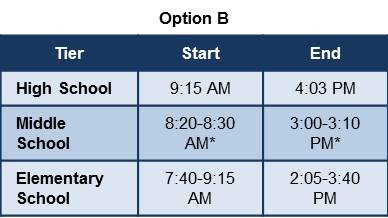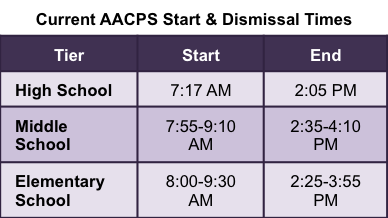Option B
NOTE: This page describes one of the models presented in October 2014 by the AACPS School Start Times Task Force. To review Superintendent George Arlotto’s proposal to shift school start and dismissal times in the 2017-2018 school year, click here .
High schools begin at 9:15AM; middle schools begin between 8:20-8:30AM (with one middle school beginning at 9:00AM); and elementary schools begin between 7:40AM and 9:15AM.
 
With this option, high school begins 118 minutes later than current start times, middle school begins 20 minutes earlier to 5 minutes later (*one middle school will start at 9:00 AM), and the elementary school start time window will open 5-10 minutes earlier. Within this elementary school window, the majority of schools will see a 5-10 minute shift in start times. However, some schools within each cluster may have significantly different start times, as determined by bus scheduling. The Transportation Office will be reviewing potential bus routes during the 2014-2015 school year.
|
|
Pros for Option B
|
Cons for Option B
|
|
Health
|
- Both high school and middle school adolescents would meet the American Association of Pediatricians (AAP) recommended school start time for adolescents.
- High school students will no longer be walking to school/bus stops in the dark during the late fall and winter months.
- High school students will have less unsupervised time after school.
|
- Many alternative and Magnet school students who are currently dropped off during Tier 4 (the last tier) at consolidated bus stops will now be dropped off much later (darkness).
- Potential safety consideration for students and Crossing Guards due to reduced visibility in the fall/winter afternoons (darkness).
|
|
After-School Activities & Sports
|
- Most elementary and middle schools begin and end at times that would allow for after-school activities.
|
- Potential impact on access to daylight for high school athletic/extra-curricular opportunities and student employment opportunities.
- If sport schedules/practices were to be moved to the morning, the potential benefits to adolescent sleep/health gains may be compromised.
- This option may have an impact on late dismissal times for Magnet Programs, Special Education Centers, Evening and Twilight Schools and schools in Tier 4 (those being dismissed late in the day).
- Evening high school will start significantly later, which could reduce the number of evening school periods from four to three. This will impact access for evening school students to earn credits at the same rate as their day school counterparts (who have four periods/day).
- Community sports and activities organized by the Anne Arundel County Department of Recreation and Parks will be delayed.
|
|
Before & After School Care
|
- Most elementary and middle schools begin and end at times that would allow for safe walking conditions and could coincide with parents' morning work schedules.
|
- Older siblings may not be able to take care of younger siblings.
|
|
Transportation
|
|
- A significant number of additional buses would need to be acquired.
- The wide range of elementary school start times will require many additional buses and could decrease bus efficiency (resulting from buses that could not service multiple tiers).
- It is expected that finding adequate numbers of certified bus drivers will be a challenge.
|
Estimated Annual Cost: $9,400,000
Transportation: $8,900,000
How were these transportation costs determined?
This option will require 131 additional buses. Significant adjustments to transportation schedules would be needed because buses often run multiple routes serving schools at different grade levels. Because this option would change the tiered structures of elementary, middle, and high schools, the necessary route changes would be substantial and would require many additional buses.
Staffing: $500,000
This option will require 7 additional employees to help manage the additional buses and transportation routes (one transportation specialist, technician and driver trainer handles an average of 65 buses):
- 2 Area Specialists
- 2 Operational Technicians
- 2 Driver/Trainers
- 1 Clerical Staff
Click here to see all start time options.
|


